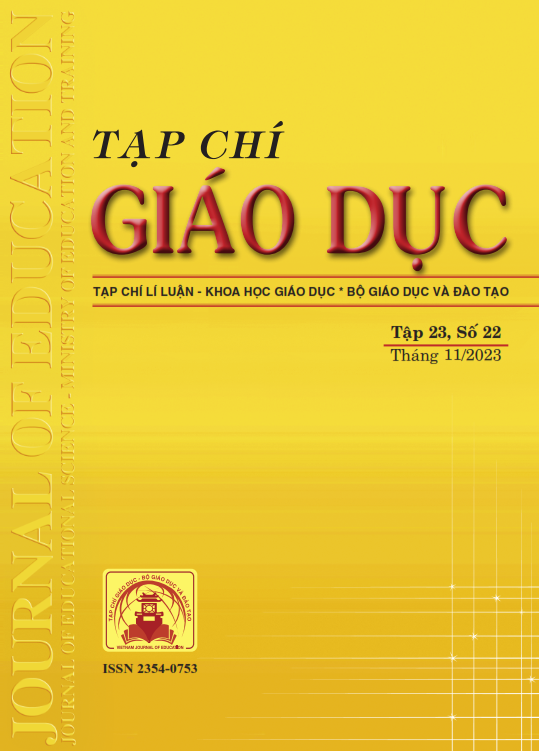Một số vấn đề lí luận về đánh giá năng lực ngôn ngữ của trẻ 12-36 tháng tuổi
Tóm tắt
The language development of 12-36 month-old children has a great impact on the formation and overall development of the child's personality. To develop language for children of this age group in a comprehensive, complete and appropriate manner, it is necessary to conduct an assessment of the child's language proficiency at each different stage in the period from 12-36 months. The article summarizes some theoretical issues about language capacity of 12-36-month-old children and the significance goals, content, and methods of assessing language capacity of 12-36 month-old children. Assessment of language ability is critical as a basis for building a plan to organize language development activities for children and to improve and innovate content and methods with the aim of effectively promoting children’s language development.
Tài liệu tham khảo
Bates, E., Benignl, L., Bretherton, I., Camionl., L., & Volterra, V. (1977). From gesture to the first word. In M. Lewis & L. & Rosenblum (Eds.), Interaction, conversation, and the development of language (pp. 247-307). New York: Willey.
Bates, E., Benignl, L., Bretherton, I., Camionl., L., & Volterra, V. (1979). The emergence of symbols: Cognition and communication in infancy. New York: Academic Press.
Bloom, L. & Lahey, M. (1978). Language development and language disorders. New York: Wiley and Sons.
Bloom, L. (1970). Language Development: Form and function of emerging grammars. Cambridge, MA: The MIT Press.
Bộ GD-ĐT (2021). Chương trình giáo dục mầm non (ban hành kèm theo Thông tư số 01/VBHN-BGDĐT ngày 13/4/2021 của Bộ GD-ĐT).
Bzoch, K. R., & League, R. (1971). Receptive - Expressive Emergent Language Scale. Austin, TX: Pro - Ed. Sequenced Inventory of Communicative Development.
Đinh Hồng Thái (2013). Giáo trình phát triển ngôn ngữ tuổi mầm non. NXB Đại học Sư phạm.
Hedrick, D. L., Prather E. M., & Tobin A. R. (1975). Sequenced Inventory of Communication Development. Seattle: University of Washington Press - Initial Communication Process Scale.
Hoàng Phê (chủ biên, 2002). Từ điển tiếng Việt. NXB Đà Nẵng.
Lã Thị Bắc Lý, Nguyễn Thị Thu Nga, Cao Thị Hồng Nhung (2021). Xây dựng tiêu chí đánh giá sự phát triển lời nói mạch lạc của trẻ 5-6 tuổi. Tạp chí Khoa học giáo dục Việt Nam, 48, 42-47.
Nguyễn Quang (2016). Từ năng lực ngôn ngữ đến năng lực liên văn hóa. Tạp chí Khoa học, Đại học Quốc gia Hà Nội, Nghiên cứu nước ngoài, 32(3), 1-9.
Nguyễn Thị Bích Thuỷ (chủ nhiệm đề tài, 2015). Nghiên cứu công cụ đánh giá năng lực ngôn ngữ của trẻ mẫu giáo 3-6 tuổi. Đề tài khoa học và công nghệ cấp Bộ, Bộ GD-ĐT, mã số: B2011-34-13.
Nguyễn Thị Phương Nga (2012). Phương pháp phát triển ngôn ngữ cho trẻ mầm non. NXB Giáo dục Việt Nam.
Nguyễn Xuân Khoa (1999). Phương pháp phát triển ngôn ngữ cho trẻ mẫu giáo. NXB Đại học Quốc gia Hà Nội.
Schery, T., & Glover, A. (1982). The initial communication prosesses scale. Monterey, CA: Publishers Test Service.
Young-tae, K., Tae-je, S., & Yoon-gyeong, L. (2013). Thang đo sự phát triển ngôn ngữ tiếp nhận và ngôn ngữ diễn đạt của trẻ mầm non. Trung tâm phục hồi chức năng cho trẻ khuyết tật ở Seoul (김영태, 성태제, 이윤경 (2013). 취학전 아동의 수용언어 및 표현언어 발달 척도, 서울자애인종합복지관).
Tải xuống
Đã Xuất bản
Cách trích dẫn
Số
Chuyên mục
Giấy phép

Tác phẩm này được cấp phép theo Ghi nhận tác giả của Creative Commons Giấy phép quốc tế 4.0 .












